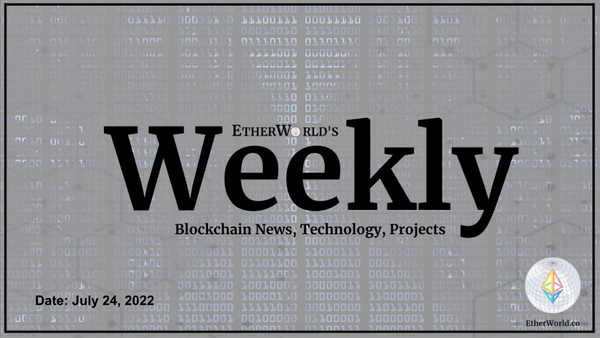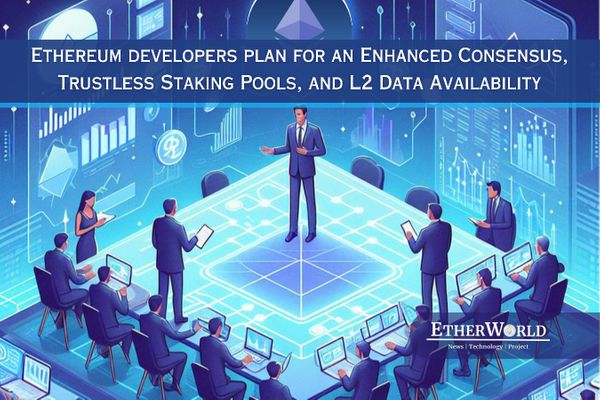The Ethereum blockchain deployed multiple network upgrades in 2021 in order to get ready for the biggest shift in the coming year - The Merge. Altair, the only beacon chain upgrade was deployed in October. Whereas on the Ethereum proof of work chain, Berlin, London & Arrow Glacier was activated in April, August, December repectively.
Kintsugi, the first public testnet is live. We've documented How to Join Ethereum Merge Kintsugi Testnet? with ELI5 explainer for dApp developers & tinkerer to join the Ethereum testnet today!
The Merge is Ethereum's transition from Proof-of-Work to Proof-of-Stake consensus, with the main goal of improving the Ethereum ecosystem's scalability, sustainability, and security. In this article, we will get to know what to expcet with this upgrade of the Ethereum blockchain.
| Table of Contents |
|---|
| 1. What is The Merge? |
| 2. Block structure representation |
| 3. Post-merge client architecture |
| 4. Consistency check |
| 5. Upcoming changes - renaming terms, post-merge upgrades |
| 6. Frequently Asked Questions |
Fun fact
The Merge was previously referred as
docking. As explained by the developers, "consider Ethereum to be a spaceship that isn't quite ready for interstellar travel. The community constructed a new engine and a hardened hull using the Beacon Chain. When the time comes, the existing ship will dock with the new system, combining into a single ship ready to put in some serious lightyears and take on the universe."
What is The Merge?
This upgrade marks the official transition of Ethereum blockchain to proof-of-stake consensus. The present Ethereum Mainnet (PoW) will merge with the Beacon Chain (PoS). Expected in the Q1/Q2 of 2022, this will bring the end of Ethereum's Proof-of-Work consensus to finalize the next block.

Image Source: Ben Edgington
Block Structure Representation

Image: Danny Ryan
Beacon chain node (Eth2)
The present Beacon block contains pieces of consensus-related information, called Operations, such as attestations, the deposit contract root, and validator slashings/exits, but do not contain any "transactions" as is there in the Ethereum proof of work block.
From an end user's perspective, a Beacon node contains empty blocks and makes consensus decisions with the help of the validators using the Fork Choice rule.
Ethereum PoW chain (Eth1)
On the other side, the Ethereum PoW block, contains transaction information, smart contract interaction along with other basic state roots, parent hash, etc. The decision to include the next block in the chain is solely decided by the miners who are participating in the mining block. However, this will be changed with the Merge.
Once the Merge arrives, the TERMINAL_TOTAL_DIFFICULTY(TTD) is hit, they're on all the subsequent blocks will be produced and attested to by the validators on the Beacon Chain.
As explained in the above diagram, the present Ethereum POW & beacon chain block will be the components of the future Ethereum block.
Read More: All about the duties, rewards & penalties of validators on the Beacon chain, POW chain block structure and Ethereum ecosystem to understand the working of blocks in Ethereum blockchain.
Post-Merge Client Architecture
If a user wants to run a full Ethereum node post Merge, the architecture will look similar to this beautifully illustrated diagram by Danny Ryan.

Image: Danny Ryan
Consistency checks
Transition state consistency between counterparties is critical for the transition process of a single node and overall network. It is important that Consensus and execution counterparties maintain their own states, which in a normal case must be consistent with each other.
-
Operating mode: PoW/PoS node operating mode. This is not critical for the operation of the node but should improve UX, especially during bootstrap of a fresh node.
-
Block trees: Beacon block and execution block trees should be consistent with respect to each other, likewise, the fork choice state (the head of the chain and the most recent finalized block). In case of software crash or temporal outage (on any side of the communication stack), consistency of block trees might be broken.
Mikhail Kalinin, the Merge developer further suggested to add a concept of consistency checks into the design of the API in Engine API design space. The goal is to enable each party to respond with the corresponding status message upon receiving a request, and then proceed either with the recovery process or a normal operating mode.
History to date
In 2013, Vitalik Buterin published the Ethereum whitepaper. In 2015, It was launched with Proof-of-Work consensus. Ethereum community tried very hard to develop a consensus mechanism for fulfilling the Eth2 vision. In 2014, Vitalik Buterin proposed the concept of Slasher. In 2015, Vitalik Buterin proposed the concept of Consenus by Bit and Vlad Zamfir proposed the concept of Casper “the Friendly Ghost”. But all of this was not able to solve the Scalability Trilemma. So Ethereum Community Team comes up with solution to this Scalability Trilemma i.e. Beacon Chain(or POS chain). Since its launch in December 2020 the Beacon chain has been finalizing 100% of its epochs with no downtime. Merge is an Ethereum upgrade that replaces the existing Proof-of-Work to Proof-of-Stake consensus.
At present, the Ethereum Mainnet block inclusion is decided by the Proof-of-Workalgorithm, whereas the Beacon Chain which is running in parallel to the mainnet is secured by proof-of-stake. The merging is the point at which these two systems eventually come together.
Benefits of the Merge:
- Eliminates the need for energy-intensive mining
- Environmentally friendly mining
- Secures the Network using Staked Ether
- Scalability Increases
- Helping in fulfilling the Eth2 vision
Upcoming changes
Renaming terms
It is worth noting the upcoming changes in the terminology other than the architecture. At present, there are two Ethereum chains running on the mainnet in parallel also known as Eth1 and Eth2. With the merge there will be only one chain and hence these will be just the components of one mainnet. Ethereum developers decided to rename in order to provide a better understanding of the architecture.
- Ethereum mainnet / Eth 1 - Execution Layer (EL)
- Beacon chain / Eth 2 - Consensus Layer (CL)
- Communication between the two layers - Engine API
Post Merge upgrades
Post merge cleanup upgrade could take the presedence for both Execultion & Consensus layer chain before any further feature or improvement proposal is added to the network. Some of the expected improvements post merge are:
- Enabling withdrawal We will not be able to withdraw our staked ETH and rewards immediately following the merge, but we will be able to deposit ETH.The option to withdraw our staked ETH and rewards will be enabled in the first hard fork that occurs after the merging.
- Removing ETH1 Data Voting: At present, this is used by the Proof of Stake chain to communicate with the Proof-of-Work chain. Some technical modifications are deactivating this process.
- Implementing proposals to improve gas fees issues like EIP-4488:: Transaction calldata gas cost reduction with total calldata limit & EIP-4444: Bound Historical Data in Execution Clients
Changing the Serialization Execution Layers,Deleting RLPandAdding SSZ in additional placesare some additional changes.Removing the Unnecessary CodeandAdding some Opcodesto access more information about the Proof of Stake change.
Note: These modifications could have happened at the same time as the merging, but Team is postponing this stuff after the merge to ensure that the merge happens as fast as possible.
Conclusion
The goal of the Merge and upcoming upgrades is to make Ethereum the most powerful, most used, most credibly-neutral, and most energy-efficient blockchain network in the world.
FAQs
Q. Which tasks are completed and current status of the Merge Upgrade?
- The Ethereum Community Team has developed a Merge Mainnet Readiness Checklist, so that users can get an idea of what is completed and what is ongoing in the Merge Upgrade. This document outlines the various tasks that must be completed in order for the merge to be ready for mainnet release.
Q. What is Merge in simple words?
- It is an Ethereum upgrade that replaces the existing Proof-of-Work to Proof-of-Stake consensus.
Q. Are there any Risks Associated with Merge?
- When implementing major changes to a protocol that handles hundreds of billions of dollars, there are always risks. But the beacon chain has been running without issues since December 2020. There are multiple unique client implementations of PoS Ethereum nodes. This implies that if a PoS node operator has problems with a particular implementation, they will be able to switch to a different client. Years of research and hard work have resulted in the Merge. Everything in use will have been thoroughly tested, battle tested, and verified.
Q. Can users remain in the PoW version of Ethereum after Merge?
- There will be only one Ethereum chain and the existing PoW chain will be the part of the blockchain as execution layer. The consensus decision will be by the present beacon chain which will then be called as the consensus layer. Users who decide not to upgrade will continue to be on a bad chain without client support.
Q. Why is Ethereum switching to Proof of Stake?
- Although PoW is reliable and secure, it consumes a lot of energy. To generate each block on the network, miners must use powerful and energy-intensive GPUs to solve a complex mathematical problem. PoS does not need the same high-energy-consuming hardware as PoW. Any modern hardware should be good to run the software necessary to run a staking node. Furthermore, switching to PoS will save approximately 99 percent of the energy.
Other Reads
- Ethereum 2.0 Basic Terminology
- How to Join Ethereum Merge Kintsugi Testnet?
- All About The Validator In Ethereum 2.0 Beacon Chain
- How To Become An Eth2 Validator On Teku
- How To Become An Eth2 Validator on Nimbus with Hyperledger Besu
- Insight of Ethereum Arrow Glacier Network Upgrade
- All you need to know about Altair: The Beacon Chain Upgrade
- Ethereum's roadmap for 2022 and beyond!
- Ethereum Layer 2 projects: An Overview
Disclaimer: The information contained on this web page is for education purpose only. Readers are suggested to conduct their own research, review, analyze and verify the content before relying on them.
To publish press releases, project updates and guest posts with us, please email at contact@etherworld.co.
Subscribe to EtherWorld YouTube channel for easy digestable content.
Support us at Gitcoin
You've something to share with the blockchain community, join us on Discord!











